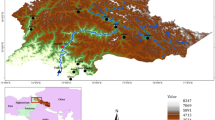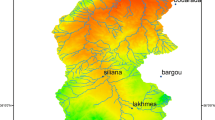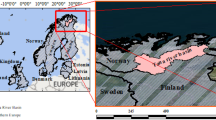Abstract
Climate change poses formidable challenges, particularly for the regions which are among the most vulnerable to these alterations. Sindh Province of Pakistan is the region of focus of this study situated in the south-east of Pakistan. The study aims to focus on model selection (General Circulation Model = GCM) and developing ensemble climate projections for the three key climate variables, rainfall, maximum and minimum temperature. For model selection, we employed Bayesian Model Averaging (BMA), utilizing observed data as the response variable and GCM outputs as predictors, for the duration of 1985–2014. For model ranking, posterior inclusion probability (PIP) is used and models with the higher PIP are preferred. For ensemble projections, BMA model is trained over the baseline period (1985–2014) and evaluated its performance both graphically and numerically. Subsequently, the trained BMA model is employed to project climate data for the target location spanning the years 2015 to 2044, under two distinct socioeconomic pathways: SSP2-4.5 and SSP5-8.5. For projections, BMA utilized the corresponding PIP as weight for each GCM, a weighting scheme established during the training period. Regarding model selection, top 5 models which performed better are selected for each variable. To get insight about climate change, the daily projected data was compared with baseline data on monthly and seasonal basis. The results indicate an upward trend in minimum and maximum temperatures during 2015–2044. Maximum raise in maximum and minimum temperature is 1.3oC and 0.5oC, respectively. In addition, winter season witnessed a higher increase in temperature. On the other hand, the projected precipitation has mixed trend under both SSPs. The information from this study are invaluable for policymakers, planners, and relevant stakeholders to make informed decisions against the changing climate.






Similar content being viewed by others
Data availability
The data will be available on a reasonable request.
References
Achieng KO, Zhu J (2019) Application of bayesian framework for evaluation of streamfow simulations using multiple climate models. J Hydrol 574:1110–1128. https://doi.org/10.1016/J.JHYDROL.2019.05.018
Ajami NK, Duan Q, Gao X, Sorooshian S (2006) Multimodel combination techniques for analysis of hydrological simulations: application to distributed model intercomparison project results. J Hydrometeorol 7:755–768
Ali S, Kiani RS, Reboita MS, Dan L, Eum H-II, Cho J, Dairaku K, Khan F, Shreshta M (2021) Identifying hotspots cities vulnerable to climate change in Pakistan under CMIP5 climate projections. Int J Climatology Vol 41(1):559–581. https://doi.org/10.1002/joc.6638
Anh DLT, An NT, Chandio AA (2023) Climate change and its impacts on Vietnam agriculture: A macroeconomic perspective. Ecological Informatics, vol. 74, 101960. https://doi.org/10.1016/j.ecoinf.2022.101960
Arguez A, Vose RS (2011) The definition of the standard WMO climate normal: the key to deriving alternative climate normals. Bull Am Meteorol Soc 92(6):699–704
Boulet S, Ursino M, Thall P, Jannot AS, Zohar S (2019) Bayesian variable selection based on clinical relevance weights in small Sample studies-application to Colon cancer. Stat Med 38:2228–2247. https://doi.org/10.1002/sim.8107
Brunner MI, Swain DL, Wood RR et al (2021) An extremeness threshold determines the regional response of floods to changes in rainfall extremes. Commun Earth Environ 2:173. https://doi.org/10.1038/s43247-021-00248-x
Cook ER, Palmer JG, Ahmed M, Woodhouse et al (2013) Five centuries of Upper Indus River flow from tree rings. J Hydrol 486:365–375. https://doi.org/10.1016/j.jhydrol.2013.02.004
Duan Q, Ajami NK, Gao X, Sorooshian S (2007) Multi-model ensemble hydrologic prediction using bayesian model averaging. Adv Water Resour 30(5):1371–1386
Eckstein D, Künzel V, Schäfer L, Winges M (2020) GLOBAL CLIMATE RISK INDEX 2020: who suffers most from Extreme Weather events? Weather-related loss events in 2018 and 1999 to 2018. Germanwatch e.V. Office Bonn
Fernandez C, Ley E, Steel MFJ (2001) Model uncertainty in cross-country growth regression. J Appl Econ 16:563–576. https://doi.org/10.1002/jae.263
Forster PM, Forster HI, Evans MJ et al (2020) Current and future global climate impacts resulting from COVID-19. Nat. Clim. Chang. 10, 913–919 (2020). https://doi.org/10.1038/s41558-020-0883-0
Fowler HJ, Archer DR (2005) Hydro-climatological variability in the Upper Indus Basin and implications for water resources. Regional Hydrological Impacts of Climatic Change—Impact Assessment and Decision Making (Proceedings of symposium S6 held during the Seventh IAHS Scientific Assembly at Foz do Iguaçu, Brazil
Gu L, Yin J, Gentine P et al (2023) Large anomalies in future extreme precipitation sensitivity driven by atmospheric dynamics. Nat Commun 14:3197. https://doi.org/10.1038/s41467-023-39039-7
Huang Y (2014) Comparison of general circulation model outputs and ensemble assessment of climate change using bayesian approach. Glob Planet Change 122:362–370
Intergovernmental Panel on Climate Change (2022) Climate Change 2022: Impacts, Adaptation and Vulnerability. URL: https://www.ipcc.ch/report/ar6/wg2/ (accessed on 6 Apri; 2024)
Khan F, Pilz J, Ali S (2021) Evaluation of CMIP5 models and ensemble climate projections using a bayesian approach: a case study of the Upper Indus Basin, Pakistan. Environ Ecol Stat 28:383–404. https://doi.org/10.1007/s10651-021-00490-8
Ley E, Steel MFJ (2007) Jointness in bayesian variable selection with applications to growth regression. J Macroecon 29(3):476–493. https://doi.org/10.1016/j.jmacro.2006.12.002
Li G, Shi J (2010) Application of bayesian model averaging in modeling long-term wind speed distributions. Renew Energy 35(6):1192–1202. https://doi.org/10.1016/j.renene.2009.09.003
Lutz AF, Herbert WM, Hester B, Arun BS, Philippus W, Immerzeel WW (2016) Selecting representative climate models for climate change impact studies: an advanced envelope-based selection approach. Int J Climatol 36:3988–4005. https://doi.org/10.1002/joc.4608
McSweeney CF, Jones RG, Booth BBB (2012) Selecting ensemble members to provide regional climate change information. J Clim 25:7100–7120. https://doi.org/10.1175/JCLI-D-11-00526.1
McSweeney CF, Jones RG, Lee RW, Rowel DP (2015) Selecting CMIP GCMs for downscaling over multiple regions. Clim Dyn 44:3237–3260. https://doi.org/10.1007/s00382-014-2418-8
Meyer J, Neuper M, Mathias L, Zehe E, Pfister L (2022) Atmospheric conditions favouring extreme precipitation and flash floods in temperate regions of Europe. Hydrol. Earth Syst. Sci., 26, 6163–6183, 2022. https://doi.org/10.5194/hess-26-6163-2022
Min SK, Simonis D, Hence A (2007) Probablistic climate change predictions applying bayesian model averaging. Philos Trans R Soc A 365:2103–2116. https://doi.org/10.1098/rsta.2007.2070
Myhre G, Alterskjær K, Stjern CW et al (2019) Frequency of extreme precipitation increases extensively with event rareness under global warming. Sci Rep 9:16063. https://doi.org/10.1038/s41598-019-52277-4
Otto et al. et al (2023) Environ Res : Clim 2(025001). https://doi.org/10.1088/2752-5295/acbfd5
Pakistan Bureau of Statistics (2023) URL: https://www.pbs.gov.pk/ (accessed on 17
Pakistan Meteorological Department (PMD) (2022) URL: https://www.pmd.gov.pk/en/ (accessed on 04/12/2023)
Perkins KM, Munguia N, Moure-Eraso R, Delakowitz B, Giannetti BF, Liu G, Nurunnabi M, Will M, Velazquez L (2018) International perspectives on the pedagogy of climate change. J Clean Prod 200:1043–1052
Qamer FM, Abbas S, Ahmad B et al (2023) A framework for multi-sensor satellite data to evaluate crop production losses: the case study of 2022 Pakistan floods. Sci Rep 13:4240. https://doi.org/10.1038/s41598-023-30347-y
Qu B, Zhang X, Pappenberger F, Zhang T, Fang Y (2017) Multi-model grand ensemble hydrologic forecasting in the Fu river basin using bayesian model averaging. Water 9(2):74. https://doi.org/10.3390/w9020074
Raftery AE (1993) Bayesian model selection in structural equation models. In: Bolen KA, Long JS (eds) Testing structural equation models. Sage, Boca Raton, pp 163–180
Raftery AE, Zheng Y (2003) Long-run performance of bayesian model averaging. J Am Stat Assoc 98(464):931–938. https://doi.org/10.1198/016214503000000891
Rojas R, Feyen L, Dassargues A (2008) Conceptual model uncertainty in groundwater modeling: combining generalized likelihood uncertainty estimation and bayesian model averaging. Water Resour Res. https://doi.org/10.1029/2008WR006908
Saeed A, Ali S, Khan F et al (2023) Modelling the impact of climate change on dengue outbreaks and future spatiotemporal shift in Pakistan. Environ Geochem Health 45:3489–3505. https://doi.org/10.1007/s10653-022-01429-z
Salathe EP, Mote PW, Wiley MW (2007) Review of scenario selection and downscaling methods for the assessment of climate change impacts on hydrology in the United States pacific northwest. Int J Climatol 27:1611–1621. https://doi.org/10.1002/joc.1540
Syed A, Raza T, Bhatti TT, Eash NS (2022) Climate Impacts on the agricultural sector of Pakistan: Risks and solutions. Environmental Challenges, vol. 6, 100433. https://doi.org/10.1016/j.envc.2021.100433
Tabari H (2020) Climate change impact on flood and extreme precipitation increases with water availability. Sci Rep 10, 13768 (2020). https://doi.org/10.1038/s41598-020-70816-2
Taylor KE (2001) Summarizing multiple aspects of model performance in a single diagram. J Geophys Res Atmos 106(D7):7183–7192
Ullah H, Akbar M, Khan F (2020) Construction of homogeneous climatic regions by combining cluster analysis and L-moment approach on the basis of reconnaissance Drought Index for Pakistan. Int J Climatol 40(1):324–341. https://doi.org/10.1002/joc.6214
Von der Linden W, Dose V, Von Toussaint U (2014 Jun) Bayesian probability theory: applications in the physical sciences. Cambridge University Press, p 12
Wang L, Wang L, Li Y, Wang J (2023a) A century-long analysis of global warming and earth temperature using a random walk with drift approach. Decis Analytics J 7:100237. https://doi.org/10.1016/j.dajour.2023.100237
Wang Y, Zhao N, Yin X, Wu C, Chin M, Jiao Y, Yue T (2023b) Global future population exposure to heatwaves. Environment International. vol. 178, 108049. https://doi.org/10.1016/j.envint.2023.108049
Webb GI (2017) Bayes’ rule. In: Sammut C, Webb GI (eds) Encyclopedia of Machine Learning and Data Mining. Springer, Boston, MA. https://doi.org/10.1007/978-1-4899-7687-1_21.
World Bank (2022) URL: https://www.worldbank.org/en/news/factsheet/2022/12/19/factsheet-sindh-water-and-agriculture-transformation-project (accessed on January 07, 2024)
World Bank (2023a) Agriculture, forestry and fishing, value added (% of GDP). URL: https://data.worldbank.org/indicator/NV.AGR.TOTL.ZS (access on 13 April 2024)
World Bank (2023b) Rising from the Waters: Sindh Navigates Recovery after the 2022 Floods. URL: https://www.worldbank.org/en/news/feature/2023/06/28/rising-from-the-waters-sindh-navigates-recovery-after-the-2022-floods (access on 14 April 2024)
World Economic Forum (2024) Quantifying the Impact of Climate Change on Human Health. URL: https://www.weforum.org/publications/quantifying-the-impact-of-climate-change-on-human-health/ (accessed on 6 April 2024)
World Wildlife Fund (2024) Is climate change increasing the risk of disasters? URL: https://www.worldwildlife.org/threats/effects-of-climate-change (accessed on 6 April 2024)
Worldometer URL (2023) November : https://www.worldometers.info/world-population/pakistan-population/ (accessed on 17
Zeugner S (2011) Bayesian model averaging with BMS. Technical report. http://bms.zeugner.eu/tutorials/bms.pdf
Zhang X, Srivinasan R, Bosch D (1999) Calibration and uncertainty analysis of the SWAT model using genetic algorithms and bayesian Model Averaging. J Hydrol 374(2–3):307–317
Zhang X, Srinivasan R, Bosch D (2009) Calibration and uncertainty analysis of the SWAT model using genetic algorithms and bayesian Model Averaging. J Hydrol 374(3–4):307–317. https://doi.org/10.1016/j.jhydrol.2009.06.023
Zhao W, Li A (2015) A review on land surface processes modelling over complex terrain. Advances in Meteorology, 2015
Acknowledgements
The authors are grateful to the Pakistan Meteorological Department (PMD) and World Climate Research Programme (WCRP) for providing meteorological data for selected stations.
Author information
Authors and Affiliations
Contributions
Miss A.I. completed this research work under the supervision of Dr. F.K. Mr. M.A. Helped in data curation and software. Dr. S.A. reviewed the manuscript critically for improvement.
Corresponding author
Ethics declarations
Competing interests
The authors declare that there is no competing interest among the authors.
Additional information
Publisher’s Note
Springer Nature remains neutral with regard to jurisdictional claims in published maps and institutional affiliations.
Electronic supplementary material
Below is the link to the electronic supplementary material.
Rights and permissions
Springer Nature or its licensor (e.g. a society or other partner) holds exclusive rights to this article under a publishing agreement with the author(s) or other rightsholder(s); author self-archiving of the accepted manuscript version of this article is solely governed by the terms of such publishing agreement and applicable law.
About this article
Cite this article
Irfan, A., Khan, F., Abbas, M. et al. Enhanced climate projections over Sindh, Pakistan: a bayesian model averaging ensemble methodology. Model. Earth Syst. Environ. 10, 4401–4413 (2024). https://doi.org/10.1007/s40808-024-02028-w
Received:
Accepted:
Published:
Issue Date:
DOI: https://doi.org/10.1007/s40808-024-02028-w




